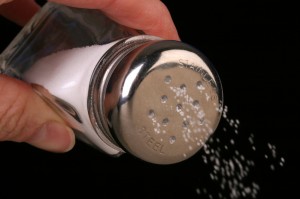 It is sometimes hard for patients to appreciate the paradox of how salt – a humble mineral with zero calories – can be bad for you if consumed at high levels in prepared foods, or simply when added to dishes at the dinner table as a “flavor enhancer.”
It is sometimes hard for patients to appreciate the paradox of how salt – a humble mineral with zero calories – can be bad for you if consumed at high levels in prepared foods, or simply when added to dishes at the dinner table as a “flavor enhancer.”
Lately I am hearing certain claims from medical sources that it may not be healthful to reduce your salt consumption abruptly. But the basic facts remain: The more salt in your diet, the higher your blood pressure, and the greater your chances of heart attack and stroke.
These are medical facts for most people. An exception would be in the cases of certain elderly or brittle patients, who, if one reduces their salt consumption significantly, might suffer a radical lowering of blood pressure, which could become dangerous to their health, or even prove fatal. But for the average American, the current salt intake is much too high. This excess of consumption constitutes a quiet but potent health hazard for millions.
But what makes salt a prime culprit in ailments that contribute to some of the leading causes of death?
The example I use when advising families on a healthier diet is the Out-to-Eat problem in America.
When going out to eat, one falls prey to a hijacking of one’s senses, and even of one’s sensibilities. Many of us realize that the larger portions served in restaurants encourage us to eat a greater volume of food. (How many of us frequently take home half of the meal “for later”?) We may also realize that many of the finer restaurant foods are calorie-dense (too much fat and sugar). We may even understand that the more varied the menu of foods and flavors, the more we are inclined to “sample” and, ultimately, to overeat.
 But do we really appreciate the subtleties of the dessert trap?
But do we really appreciate the subtleties of the dessert trap?
At the end of the main meal, when the table is cleared, even the crumbs are removed from the table cloth before the dessert menu is distributed. Is this merely the refined etiquette displayed by staff in the better restaurants that one patronizes?
Actually, this is an established technique, exploiting the fact that, once all remnants of a meal are removed from the table, the human brain resets to the ready-to-eat mode. Then comes the BIG calorie consumption of the evening, after which the belt needs to be loosened!
But returning to our principal theme, salt:
When eating out, or when consuming pre-packaged meals, one is typically enjoying food that is high in added salt content. When we consume salt at these typically high levels, we put our body chemistry out of balance.
Ten-thousand years ago in the wild, if we had too much salt, a survival instinct would be activated. Too much salt in a constantly active human body brings on a form of dehydration that can kill you. Thus, the free-range human body would crave the natural antidote to this problem – fruit. Fruit is high in water and potassium content that dilutes the salt and helps establish cellular balance. This instinctual drive to offset the effects of salt with fruit has been shown to be very powerful, like the need to take a breath at the surface when swimming under water.
And this plays back into the dessert trap. The server brings out, not the bright colored and sweet fruits of nature, but rather the man-made substitutes: a tray of bright colored, sweet, calorie-dense desserts that one craves after a salty meal as if one’s life depended on it.
So the natural human inclination is to indulge in a high-fat and sugar-dense dessert.
Some Basic Tips for Out-Smarting the Out-to-Eat Syndrome:
- Take your check before the table is cleared.
- Increase the fresh fruit and vegetable content of meals, whether dining in or out.
- Choose foods and condiments with lower salt content. For example use oil and vinegar, not pre-prepared salad dressings.
- Make fruit your dessert of choice – more restaurants offer a serving of fresh berries as an alternative to cakes and pastries. And tell them to hold the whipped cream.